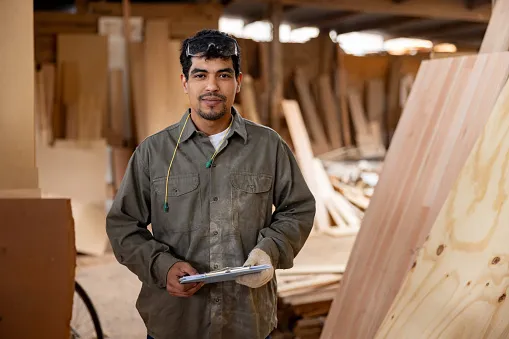
When it comes to choosing the right material for your workbench top, MDF and plywood are two popular options. Each material has its own set of advantages and disadvantages, so it’s important to weigh your options carefully before making a decision.
That way, there will be no distance at which your vices can’t hold a piece of wood. The screw mechanisms for these can be purchased separately, from various online retailers, and attached to your workbench with your own wood jaws attached to them. They are actually mounted to the underside of the workbench top. I have seen workbenches of this type which were six feet wide and eight feet long; but most are about two feet wide by six feet long. In this case, you’ll want to make the table with locking castors; preferably with all four of them having locks on them.
Another advantage is that you need not get any joints in a workbench top made of plywood. Therefore, plywood offers a popular choice for a cost-effective and durable workbench top. Unlike a woodworking tabletop, these workbenches aren’t going to be clamped and glued together, so they don’t have to be as thick and robust. Connecting the workstation to a workshop wall will make it much more stable and less likely to move. If the workstation’s frame provides enough support, a single sheet of 3/4″ plywood will suffice to construct this workbench.
MDF
Marine-grade plywood is best for a workbench top, considering the price and longevity factors. You can also use birch plywood, which is quite durable, and have it waterproofed. This article will help you decide which type of plywood is best for your woodworking workbench top. I will briefly go over why you should not make the mistake of using OSB in a workbench top (or anywhere else) and explore the different foundation options that complement plywood. By the end, you will also know how to select high-quality plywood so your workbench top is as flat as it must be. A plywood workbench top is better than OSB due to its strength per thickness comparison.
MDF (Medium Density Fiberboard) is a dense and flat material made from wood fibers that are bonded together with resin under high pressure and heat. One of the main advantages of using MDF for a workbench top is its smooth and uniform surface, which is ideal for woodworking projects that require precision. Additionally, MDF is relatively affordable and easy to find at most home improvement stores.
This type of workbench is for showing off your awesome woodworking skills. Perfect joints, sanded to a great finish (only 1000 grit will do). Usually hard-pressed to find a spec of sawdust in the vicinity. If you have the skill to make this type of bench, thanks for reading this article’ and please let me know what your workbench secrets are in the comments.
Pros of MDF:
You can order MDF boards online, knowing you won’t get a board with splinters or dents. It is made up of ground wood fibers that are pressured into a very specific mold. As a result, it is perfect for a workbench on which heavy objects are pushed vertically. Your workbench should ideally be strong enough to handle projects that require power tools.
– Smooth and flat surface
Although some, such as the southern yellow pine, are slightly yellow, pinewood is typically whitish. The main reason pine makes an excellent choice for a workbench top is that it’s easy to work with. Metal benches are sometimes preferred due to their versatility and sturdiness. A metal workbench can handle pretty much any woodworking project.
– Affordable
– Easy to find
Cons of MDF:
– Not as durable as plywood
– Prone to moisture damage
– Heavier than plywood
Plywood
Plywood is made by layering thin sheets of wood veneer and adhesive to create a strong and sturdy material. Plywood is known for its durability and resistance to moisture, making it a popular choice for workbench tops that will be subjected to heavy use. While plywood may be more expensive than MDF, its longevity and strength make it a worthwhile investment for many woodworkers.
Pros of Plywood:
– Durable and long-lasting
– Moisture resistant
– Sturdy for heavy use
Cons of Plywood:
– More expensive than MDF
– Surface may not be as smooth as MDF
– Can be harder to find in certain thicknesses
Ultimately, the decision between MDF and plywood for a workbench top will depend on your specific needs and budget. If you prioritize durability and moisture resistance, plywood may be the better choice. However, if you value affordability and a smooth surface, MDF could be the way to go. Consider your priorities and choose the material that best suits your woodworking projects.



